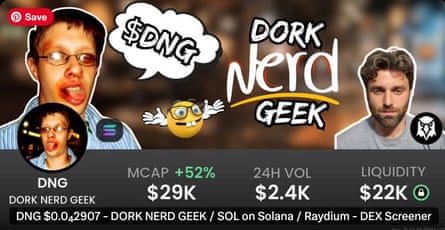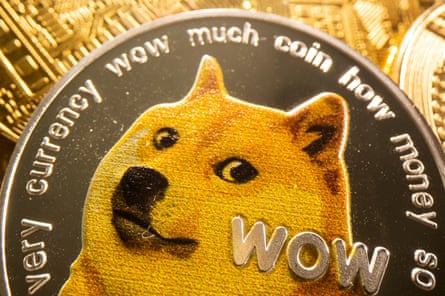In November last year, I was turned into a memecoin. Several, in fact.
Someone alerted me that a memecoin called Dork Nerd Geek ($DNG) had been minted with a picture of my face, and it already had a market cap (the total value of all coins in circulation) of $29,000. Twenty minutes later it was $100,000. An hour later it was $800,000.
I had no idea what was going on, but I did know that “Dork Nerd Geek” was the nickname Andrew Tate gave me because I’ve spent much of my journalistic career investigating allegations of human trafficking made against him.
I noticed he was currently livestreaming to his followers. I opened up his live stream and, for the first time, bore witness to the insane volatility of the memecoin market.
In the space of 10 minutes, dozens of new me-related memecoins were being minted, including “Disgraced News Gatherer”, “Matt Shea is a faggot,” and “Take My Wife Tate (CUCK),” the latter of which included a picture of my fiancee taken from Instagram. Tate was pumping some of these memecoins in value merely by talking about them, with market fluctuations happening in real time on the order of millions, based on his every word.
Two seconds after he said the words “Fuck Matt Shea,” a coin called “FUCK MATT SHAE [sic]” soared in value. Twenty minutes later, he uttered the words “Fuck Matt Shea … ” again and it went even higher, only to drop back down to nothing when he finished his sentence with “… is not a generational asset”. He then said he would pump the coin after taking a piss. He walked offscreen to urinate. It rocketed.

Soon, there were hundreds more Matt Shea memecoins with similar names, as his followers tried to trick people into thinking that their Matt Shea memecoin was the one Tate was pumping. His words became memecoins, those memecoins shot up in value, and then the value disappeared instantaneously.
All in all, about $2m was spent by people on memecoins making fun of me in the span of a few hours, and hundreds of millions more on other coins he mentioned during the stream.
By the end of his live stream, the value of all the coins he pumped was back to near zero. All the fans who had invested at his behest collectively would have lost hundreds of millions of dollars.
His followers may have felt they were in on the joke, but in the end they mostly lost their money. Only a tiny number of wallets actually profited from the coin including one crypto that made a profit of $240,000.
A number of online crypto investigators including Coffeezilla, bored2boar, StarPlatinum and others have found that Tate has manipulated memecoin markets using “pump and dump”-like schemes, leading to large profits for those within his inner circle. We put the allegations in these investigations to Tate’s team, who said they had no comment.
What happened on Tate’s stream that day felt bizarre but I didn’t completely understand what I was witnessing. I thought I basically understood bitcoin, but how do memecoins differ, and why do they continue to be popular when so many people have lost money on them?
Is every memecoin a scam?
According to David Gerard, author of Attack of the 50 Foot Blockchain: “Basically, literally, yes.”
“All of this is like a big game of pretend with made-up financial instruments,” he said. “It’s printing your own made-up money. You print your own Monopoly money and then people buy it from you for real money.”
The best thing you could possibly say about memecoins is that they initially felt like a funny, countercultural way to participate in internet culture. They satirised a financial system that increasingly looked like a silly game to those on the outside. They encapsulated a humorous generational nihilism.
According to Sander Lutz, the nation’s first crypto-focused White House correspondent: “You could consider a memecoin to be a stock in a cultural phenomenon – like Dogecoin and the Doge meme.”
“Another way of defining a memecoin,” Lutz said, “is a cryptocurrency token that has an acknowledged inherent lack of value. The crypto world, outside of memecoins, is full of so many people who are trying to pitch you on tokens that are ‘actually really profound’ or ‘represent a stake’ in some kind of ‘useful network’, but are equally worthless. What makes memecoins different is that there’s none of that noise.”
In other words, all crypto is bullshit, but memecoins are consciously bullshit.
In their essence, memecoins distill the attention economy into a tradable asset, monetising the ebb and flow of viral internet hype. This has created a system in which the biggest attention-seekers on the planet – Logan Paul, Andrew Tate, Elon Musk, Donald Trump – can bleed their followers for profit. The more controversial they are, the more viral they are; and the more viral they are, the more their memecoins increase in value. Last year, some developers performed attention-seeking stunts on livestreams to pump their tokens, leading to animal abuse and a faked suicide.
Chase Herro, the co-founder of Trump’s main crypto venture, World Liberty Financial, said about crypto: “You can literally sell shit in a can, wrapped in piss, covered in human skin, for a billion dollars if the story’s right, because people will buy it.”
Most memecoins end up making money for the person who makes them as a “rug pull” or a “pump and dump”. The term “rug pull” was actually invented by the crypto community, and it works like this:
First, you mint a memecoin, and make sure that you and your mates own most of the liquidity pool (the total number of coins in circulation). The size of the liquidity pool – the amount of that memecoin that “exists” – is, like everything else in memecoins, a totally made-up number.
Second, you generate hype around the coin by convincing people it will “moon” (shoot up in value). This usually involves getting a celebrity, influencer or the president of the US, to promote it. People then buy the coin, thinking it will be a good investment. Law of demand means that as people buy it, the “value” of the coin goes up, and since you and your mates own the lion’s share, you get richer.
Then, at a time known only to you, the creator of the coin, and other insiders, you “pull the rug”, selling off all your stock at the newly high price. You make money, and the value of the coins bought by the masses you manipulated shoots back down to zero. It’s basically a way to just trick people into giving you money, dressed up as an “investment”.
A “pump and dump” is pretty much the same thing, but with the slight caveat that you’re doing it with a coin that already exists, rather than creating your own. You buy a cheap coin, “pump” its value by hyping it so others invest, then “dump” all your stock, selling it off at a huge profit and causing everyone else to lose their money.
“It’s provably negative sum,” Gerard told me. “The only way you get money is by other people losing money.”
The only people really getting rich off memecoins are influencers and their crypto enablers (people like Herro, or Hayden Davis, the guy who helped launch Argentinian president Javier Milei’s memecoin and was involved in Melania Trump’s memecoin).

Despite this, the idea that trading memecoins is a good way to get rich persists on the internet. Is it theoretically possible for someone like you or me to invest at just the rich time and get rich off a coin?
Just as with traditional gambling, there are a tiny number of success stories, such as people like the “Moo Deng whale”, who turned $800 of Moo Deng coin (a memecoin referencing the viral pygmy hippo of the same name), into $10m.
But only 0.4% of Pump.fun (the main memecoin trading platform) traders have made more than $10,000. About 0.002% have made more than $1m.
Lutz told me: “There are a select number of people who’ve made quite a lot of money on these tokens, but they tend to be the same people. They tend to be people who are very well-connected, who are in specific group chats, and who have a lot of existing capital.”
“You’ll always have more people losing than amounts of winners,” according to Gerard. “And the winners never shut up, so you think it’s a winning environment.”
One of the main reasons people keep falling for these coins is that they think they’ve figured out the scam and invested early, before the rug pull or the dump. But this is never really the case.
According to Gerard: “Crypto has been an ever-escalating series of get-rich-quick schemes, where a whole bunch of people think that they’re smarter operators than the previous operator, and generally they’re not.”
Memecoin traders will often be invited to Discord and Telegram chats that are sold as “insider channels” where, according to Gerard, “they think they’ll hear about these scams before the rug is pulled – but actually they’re the suckers. Crypto is full of people who think they’re the scammer, not the sucker.”
Young gullible men
Despite all this, many people – especially young men – continue to invest in memecoins.
Forty-two percent of men and 17% of women aged 18 to 29 have invested in, traded or used crypto, according to a 2024 Pew Research Center study, compared to only 11% of men and 5% of women over 50.
“It’s no accident that memecoins are such a phenomenon among young people who have grown immensely frustrated with a financial system that, I think it’s fair to say, has failed them,” Lutz explained, “and where supposedly sure investments aren’t likely to give them returns that would give them the quality of life their parents had. Memecoins are nakedly meaningless, but there are many financial products, both in crypto and in the world of traditional finance, that may profess to have meaning, but at their core may be nearly as meaningless to young people.”
This, too, is why memecoins have become popular with far-right, manosphere influencers and their fans.
“It’s undeniable,” Lutz said, “that the trend in memecoin popularity among younger people – in particular young men – is part of the same trend where you’re seeing a loss of trust in institutions and a loss of confidence that traditional paths to success work out.”
“These are the same tenets that have brought young men into the fold of the Maga-verse or to influencers like Andrew Tate. There’s overlap between them because they both stem from the same frustrations affecting so many young people, in particular young men, who feel more anger, bitterness, disillusionment and nihilism than a generation ago.”
Some people don’t even seem to care that they’re being scammed, according to Lutz. “It’s remarkable to see the culture in these ecosystems, because someone will rug-pull a project – what you would consider to be a scam in that they’re running you out of the money – but that’s kind of an accepted practice and people are like, ‘Hey, good for them, I got screwed over, on to the next one.’”
“There are too many cases to count of people who’ve lost their entire savings gambling on new coins. If you’re a gambler at a casino, there’s Gamblers Anonymous and an existing infrastructure to deal with people who are addicted to gambling. At casinos you have ‘no play’ lists in compliance with existing laws. There’s no existing infrastructure to aid people who lose all of their savings on memecoins.”
Some memecoins try to claim that they’re more than just high-stakes gambling, in order to ensnare more willing buyers. These coins are often accompanied by the false promise of some kind of utility, be it “roadmaps”, “airdrops” ( free tokens given out for marketing purposes), off-chain value mechanisms, games where you can “spend” the coins, and various incomprehensible frameworks using the coin to vote or create some sort of ecosystem. The utility almost never materialises. $Batman coin promised to integrate “entertainment, gaming, and real-world utility”. Logan Paul’s $ZooToken supposedly allowed buyers to play a Pokemon-like game which never worked.
The exception, the one memecoin to offer a tangible benefit in the real world, is the one sold by the president.
President Meme
On 17 January, three days before his second inauguration, Trump launched his own memecoin, $Trump. At the time of writing, the coin’s market cap is over $2.5bn, spurred on by Trump offering a dinner and White House tour to the top owners of the coin, which took place last weekend.
Unlike other memecoins, it offered something concrete: access to the president. This made its value soar.

Right now, only 20% of the token’s total “supply” is currently in circulation. The remaining 80% is supposedly held by Trump and his business partners.
Trump and his business partners are supposedly only allowed to sell off their holdings in $Trump when they are “unlocked” in tranches over time, according to their own made-up rules. As Gerard puts it: “They own the fake money, but they can’t sell it until it’s unlocked in tranches. Note that the limits are artificial. I mean, they could just ‘print’ more.”
But already, “58 wallets have made over $10m each from President Donald Trump’s meme coin, totaling $1.1bn in profits”, while “764,000 wallets of mostly small holders have lost money on $TRUMP”, according to CNBC.
Gerard said: “A lot of his own fans bought the coin. They thought it would be a fabulous success because Trump is a ‘business genius’. He ripped off his own fans.
“The coins’ creators and original sponsors get free $Trump coins and they can dump those on the market at will every time a tranche is released. And they do. And are people ever going to make money on those $Trump coins they bought? Probably not. The money goes to the Trump family, and that’s the direction it was created to make it go in. So yeah, it’s a memecoin dump. He’s just dumping the coins on the suckers and it’s a textbook case.”
Trump and his business partners also profit in transaction fees every time $Trump is traded, so far earning $100m.
Whether this is all legal or not is up for debate, but soon after launching his own memecoin, Trump replaced the head of the regulator responsible for memecoins, the SEC, with a pro-crypto appointee.
Lutz said: “In the last few months, the SEC has either dismissed or withdrawn all of its crypto-related lawsuits against every big crypto company in the United States and closed all of its investigations. I mean, the SEC is hosting roundtables almost every week with crypto companies, asking how it can be more helpful to the industry.”
Trump has also enthusiastically supported a legal framework for stablecoins. Stablecoins are theoretically stabilised in value by being “pegged” to the value of another asset like the US dollar, but in reality have often become “de-pegged” and therefore unstable.
Right now, the Stable Bill and the Genius Bill, which reference Trump calling himself a “stable genius” in 2018, are trying to make their way through Congress. They pave the way for the US government to use stablecoins to pay everything from housing grants to social security payments. And Trump himself just so happens to have a stablecoin of his own – through the World Liberty Financial company – which would shoot up in value if these bills pass, earning his family trust potential billions.
The Trump family has a claim on 75% of net revenues from World Liberty’s token sales.
“It is absolutely the government’s job to stop mis-selling of investments – that’s why ordinary retail mums and dads cannot buy into binary options,” Gerard said. “It’s absolutely open slather for crypto in the US now. This is really bad. A lot of people are going to get skinned. It’s going to be terrible.”
The advice? Stay away
Is there any cause for hope? According to Gerard, while it may appear everyone is investing in memecoins, this is mainly exaggerated by the media. Sure, lots of young people have dabbled, but only the real crypto geeks are actually buying the things.
“The good news is most people are not falling for it. And our evidence for this is the retail dollar trading volumes at Coinbase, the largest crypto dollar exchange. Coinbase happens to be a public company so that means they have to give accurate numbers to the SEC. So they disclosed their retail trading volumes. They’re down 17% in the first quarter of 2025 from where they were in December 2024. They’ve gone down with the Trump coin regime. That gives hope.”
As far as my own memecoins go, even the Tate fans who invested appear to have become aware of the scam they fell for.
Shortly after the stream went dead, I received an email from a Tate follower titled: “MATT SHAE WE NEED YOUR HELP.” He, along with other Tate fans, claimed they were victims of Tate rug-pulling them. They wanted me to help spread awareness of their community’s plight – by publicizing a new memecoin they had minted called $RRT (Real Rugger Tate).
I didn’t write back.

 3 months ago
120
3 months ago
120

















































